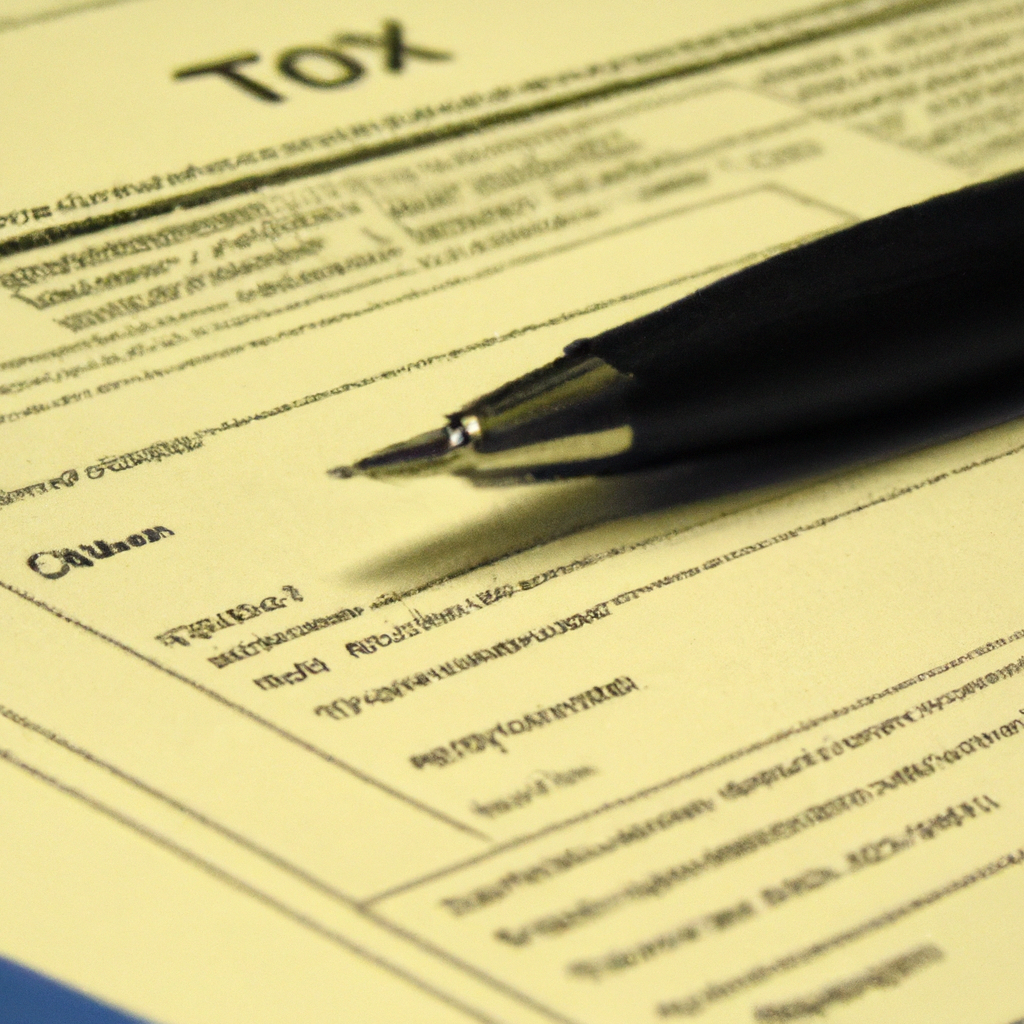Failing to sign and date your tax return may seem like a small oversight, but it can have significant consequences. Not only can it cause frustrating processing delays, but it may even invalidate your submission altogether. This seemingly innocent mistake can result in missed deadlines and potential penalties. However, by taking a few extra minutes to ensure you have signed and dated your tax return, you can avoid these complications and ensure a smooth and timely processing of your taxes.
Introduction
When it comes to filing your tax return, it’s crucial not to overlook the importance of signing and dating it. Neglecting to do so can have serious consequences. In this article, we will explore the potential issues that can arise from neglecting to sign and date your tax return, the reasons why people might make this mistake, and how to avoid these pitfalls. By understanding the importance of these simple steps, you can ensure that your tax return is processed efficiently and accurately.
Consequences of Neglecting to Sign and Date
Delays in Processing
One of the most immediate consequences of failing to sign and date your tax return is processing delays. Without your signature and the date, the Internal Revenue Service (IRS) may not complete the processing of your return. This can result in a longer waiting time for any refunds you may be entitled to receive. The delay in processing can be frustrating and may even cause financial hardship if you were relying on a timely refund.
Invalidation of Submission
Furthermore, neglecting to sign and date your tax return can invalidate the submission altogether. From a legal standpoint, a tax return is considered incomplete and non-binding without the appropriate signature and date. This means that the IRS may not recognize the return as valid, and you may be subjected to further actions or penalties. It is essential to understand that without a proper signature and date, your tax return cannot be considered as a legally binding document.

Reasons for Neglecting to Sign and Date
Forgetfulness
One common reason why individuals neglect to sign and date their tax returns is forgetfulness. With the numerous forms and documents involved in the tax filing process, it’s easy to overlook this seemingly minor detail. However, forgetting to sign and date your tax return can have significant implications. It is essential to develop a consistent routine and make signing and dating your return a priority.
Ignorance of Importance
Some taxpayers neglect to sign and date their returns simply because they are unaware of the importance of these steps. They may mistakenly believe that the signature and date are merely formalities, rather than crucial components of a complete tax return. To avoid falling into this trap, it is vital to educate yourself on the significance of signing and dating your tax return and how it affects the filing process.
Misunderstanding of Requirements
Another reason for neglecting to sign and date a tax return is a misunderstanding of the filing requirements. It’s possible that individuals may be unaware that their signature and date are necessary elements of a complete return. Familiarizing yourself with the specific requirements outlined by the IRS can go a long way in ensuring that you meet all the necessary criteria for a valid tax return.
Delays in Processing
Increased Waiting Time for Refunds
By failing to sign and date your tax return, you risk encountering delays in receiving any refunds owed to you. The IRS cannot process your return without the required signature and date, resulting in a longer waiting period. Receiving a refund promptly can be crucial for many individuals, so it is essential not to overlook this step.
Possible Late-Filing Penalties
Moreover, neglecting to sign and date your tax return can have legal implications. If your return remains incomplete due to the absence of a signature and date, it may be considered late or even non-filed. This can lead to penalties imposed by the IRS, increasing your financial burden further. To avoid potential penalties, it is crucial to ensure that your tax return is properly signed and dated before submission.
Risk of Missing Important Deadlines
In addition to delays and penalties, failing to sign and date your tax return can also put you at risk of missing important deadlines. If your return is not deemed valid due to the absence of a signature or date, you may miss out on various opportunities, such as claiming tax credits or deductions. It is essential to understand that a complete, signed, and dated tax return is necessary to ensure you meet all deadlines and take advantage of available tax benefits.

Invalidation of Submission
Potential Audit Triggers
Neglecting to sign and date your tax return can raise red flags and potentially trigger an audit. The IRS pays close attention to incomplete or improperly filed returns, and a missing signature and date can be seen as a reason for further examination. An audit can be time-consuming, stressful, and may lead to additional taxes owed. To avoid unnecessary scrutiny from the IRS, make sure your tax return is complete and properly signed and dated.
Loss of Eligibility for Tax Credits or Deductions
An invalid tax return can also result in the loss of eligibility for valuable tax credits or deductions. Certain benefits are contingent upon submitting a complete and accurate tax return, including the appropriate signatures and dates. Failing to meet these requirements can result in a loss of potential tax savings. To maximize your benefits and avoid missing out on valuable credits or deductions, ensure that your return is properly signed and dated.
Lack of Legal Binding
Without the necessary signature and date, your tax return lacks legal binding, rendering it incomplete and potentially non-binding. This means that the IRS may not recognize the return as a valid document for taxation purposes. It is crucial to remember that a signed and dated tax return is a legal declaration, affirming the accuracy and completeness of the information provided. To ensure that your tax return holds legal weight, always sign and date it appropriately.
Preventing Processing Delays
Check Accuracy and Completeness of Return
To avoid delays in processing, it is essential to review and double-check the accuracy and completeness of your tax return. Take the time to verify that all information is correct, and all necessary forms and schedules are included. By being thorough in your review, you can mitigate the risk of errors and omissions, reducing the chances of processing delays.
Use Electronic Filing Options
Using electronic filing options can significantly expedite the processing of your tax return. Many tax preparation software and online platforms provide efficient and secure electronic filing services. Electronic filing eliminates the need for physical signatures and dates, as the software or platform will automatically apply an electronic signature and date to your return. This not only saves time but also ensures the validity of your submission.
Follow IRS Instructions Closely
Following the instructions provided by the IRS is crucial to avoid processing delays. The IRS provides detailed guidelines on how to properly sign and date your tax return, addressing any specific requirements or exceptions. Make sure to read and understand these instructions carefully before submitting your return to ensure compliance and expedite processing.

Ensuring Valid Submission
Double-Check Signature and Date
Before submitting your tax return, take a moment to double-check the signature and date. Ensure that your signature is legible and matches the name used throughout your return. Additionally, confirm that the date reflects the current tax year and is within the appropriate timeframe. By verifying these details, you can ensure the validity of your submission and prevent any potential issues.
Understand Specific Requirements for Joint Returns
If you are filing a joint return, it is vital to understand the specific requirements for signatures and dates. Both spouses must sign and date the return, and failure to do so can invalidate the submission. It is essential to communicate and coordinate with your spouse to ensure that all necessary signatures and dates are included on the joint return.
Attach Supporting Documentation if Required
Certain tax returns may require supporting documentation to accompany your submission. It is crucial to understand any additional requirements outlined by the IRS and attach the necessary documentation. Failure to provide required supporting documents can lead to delays or even rejection of your tax return. To ensure a valid submission, carefully review the instructions and include all relevant documentation as needed.
Common Mistakes to Avoid
Using Incorrect Signature
Using an incorrect signature is a common mistake that can compromise the validity of your tax return. It is important to use your legal signature, which matches the name used throughout the return. Avoid using nicknames, abbreviated signatures, or any other variations that may raise concerns about the authenticity of the signature.
Forgetting to Date or Using Incorrect Date
Forgetting to date your tax return or using an incorrect date is another common mistake to avoid. The date should reflect the current tax year and be within the appropriate timeframe for filing. Omitting or misdating the return can render it incomplete or raise suspicions about its accuracy.
Missing Signature on Joint Return
If you are filing a joint return with your spouse, ensure that both signatures are present. The absence of a signature from either spouse can invalidate the entire submission. Communicate with your spouse to ensure both signatures are included, reinforcing the validity of your joint return.
Consequences for e-Filed Returns
Electronic Signature Options
When e-filing your tax return, you have various electronic signature options available to you. These may include using a self-selected personal identification number (PIN) or utilizing the signature feature provided by the tax preparation software or online platform you are using. Familiarize yourself with the electronic signature options and choose the most appropriate method for your e-filing needs.
Importance of Personal Identification Number (PIN)
If you opt to use a PIN to electronically sign your tax return, it is essential to safeguard this personal identification number. Your PIN serves as your electronic signature and should not be shared with anyone. Protecting your PIN helps maintain the integrity and security of your electronically filed tax return.
Consequences for Mailed Returns
Mailing Address and Signature Locations
When sending a paper copy of your tax return through mail, it’s crucial to ensure that you are mailing it to the correct IRS address. The IRS provides specific addresses for different types of tax returns, so verify the correct mailing address before sending your return. Additionally, sign your tax return in the designated area provided, typically located on the last page of the tax form.
Use of Certified Mail or Return Receipt
To add an extra layer of security and ensure proof of delivery, consider using certified mail or requesting a return receipt when mailing your tax return. These options provide confirmation that your tax return was successfully delivered to the IRS, providing peace of mind and protection against potential disputes or lost mail situations.
In conclusion, neglecting to sign and date your tax return can have severe consequences, ranging from processing delays to the invalidation of your submission. By understanding the potential issues that can arise from this oversight and taking proactive measures to prevent them, you can ensure that your tax return is processed efficiently and accurately. Be mindful of the specific requirements outlined by the IRS, double-check your signature and date, and consider using electronic filing options for a smoother and more secure tax filing experience. Remember, signing and dating your tax return is not just a formality – it is a fundamental step in fulfilling your tax obligations and maintaining compliance with the IRS.

